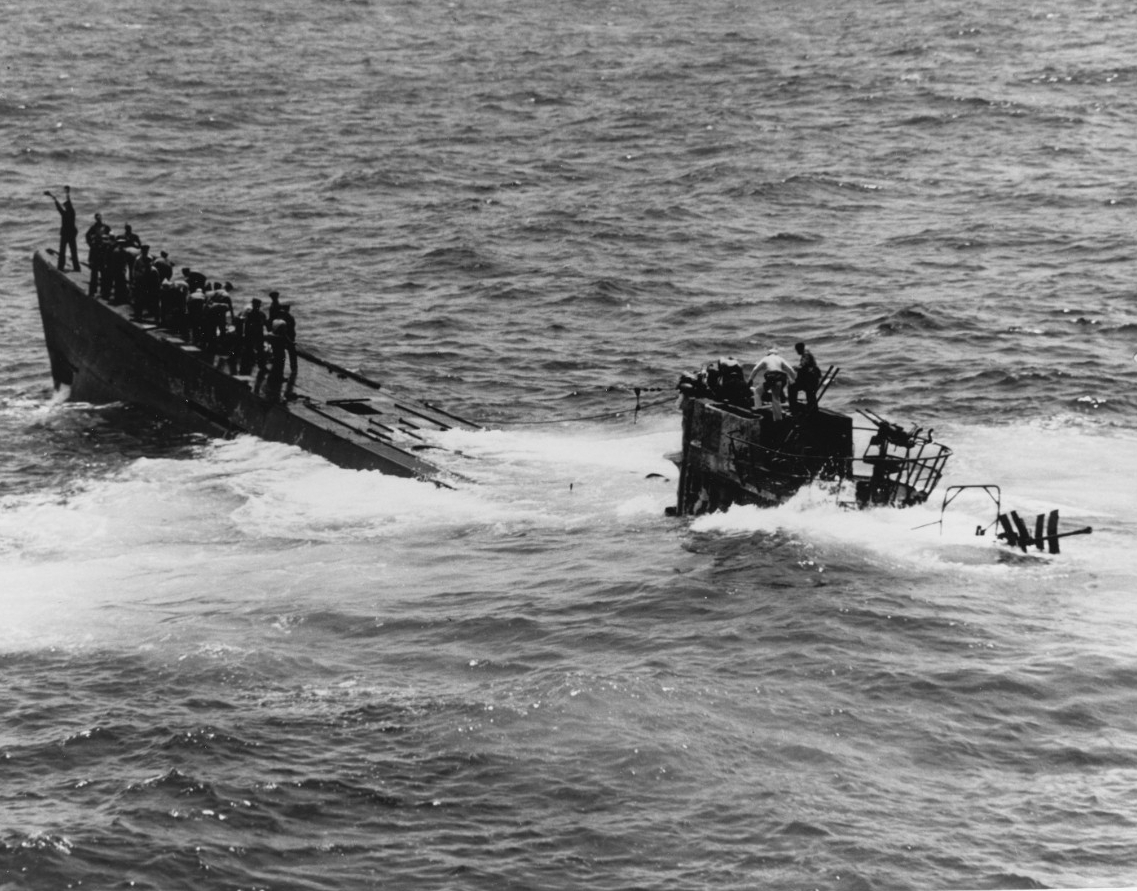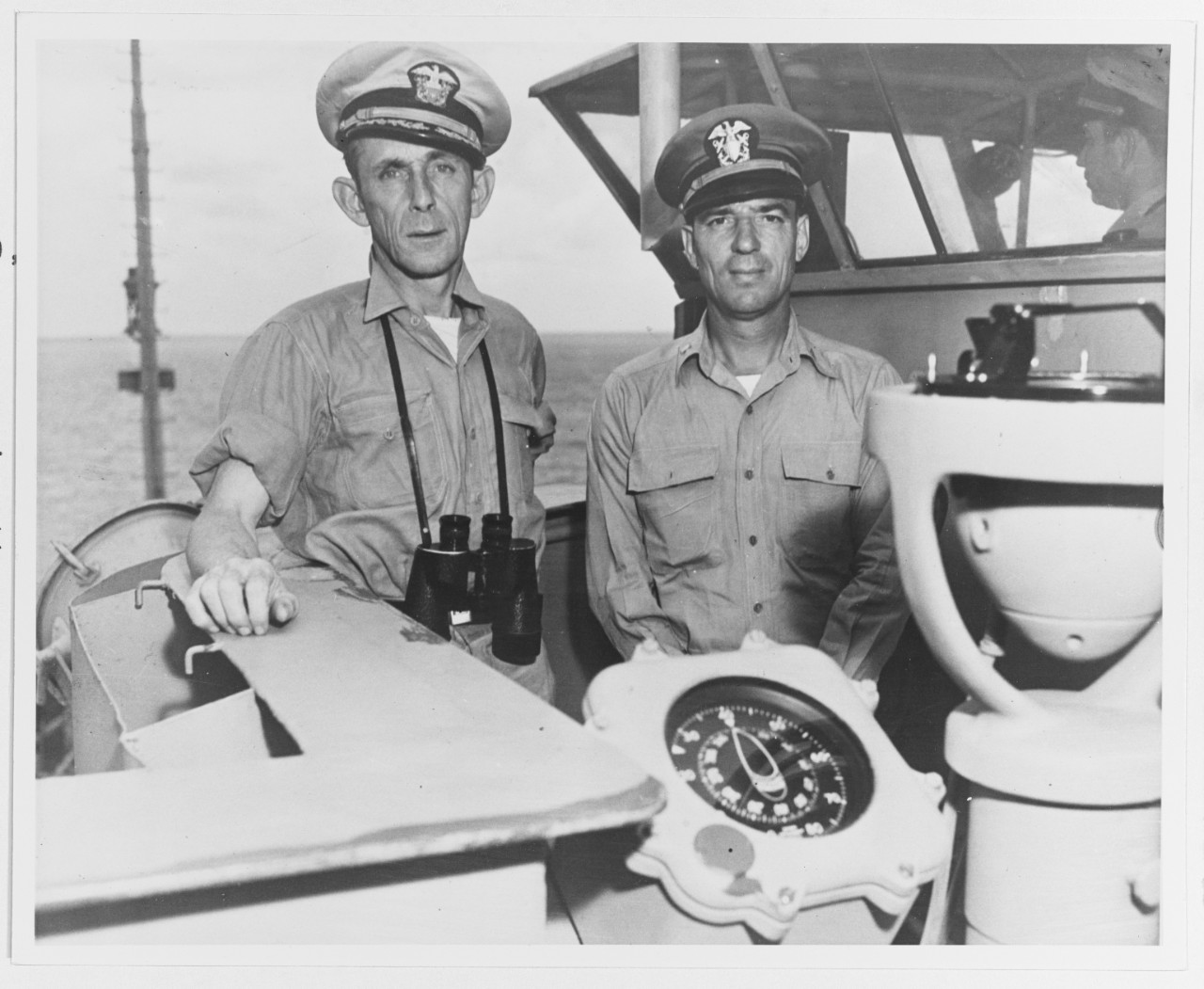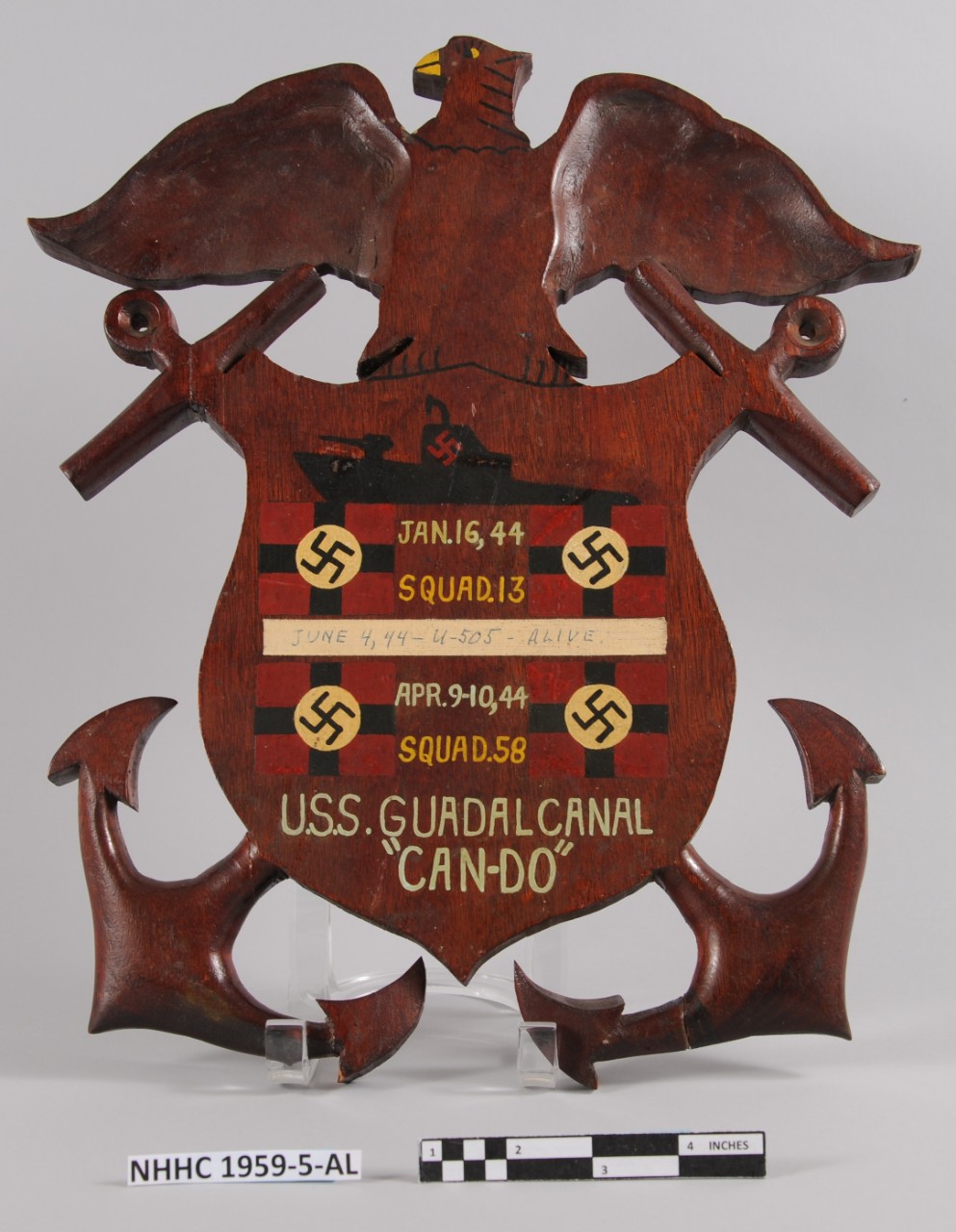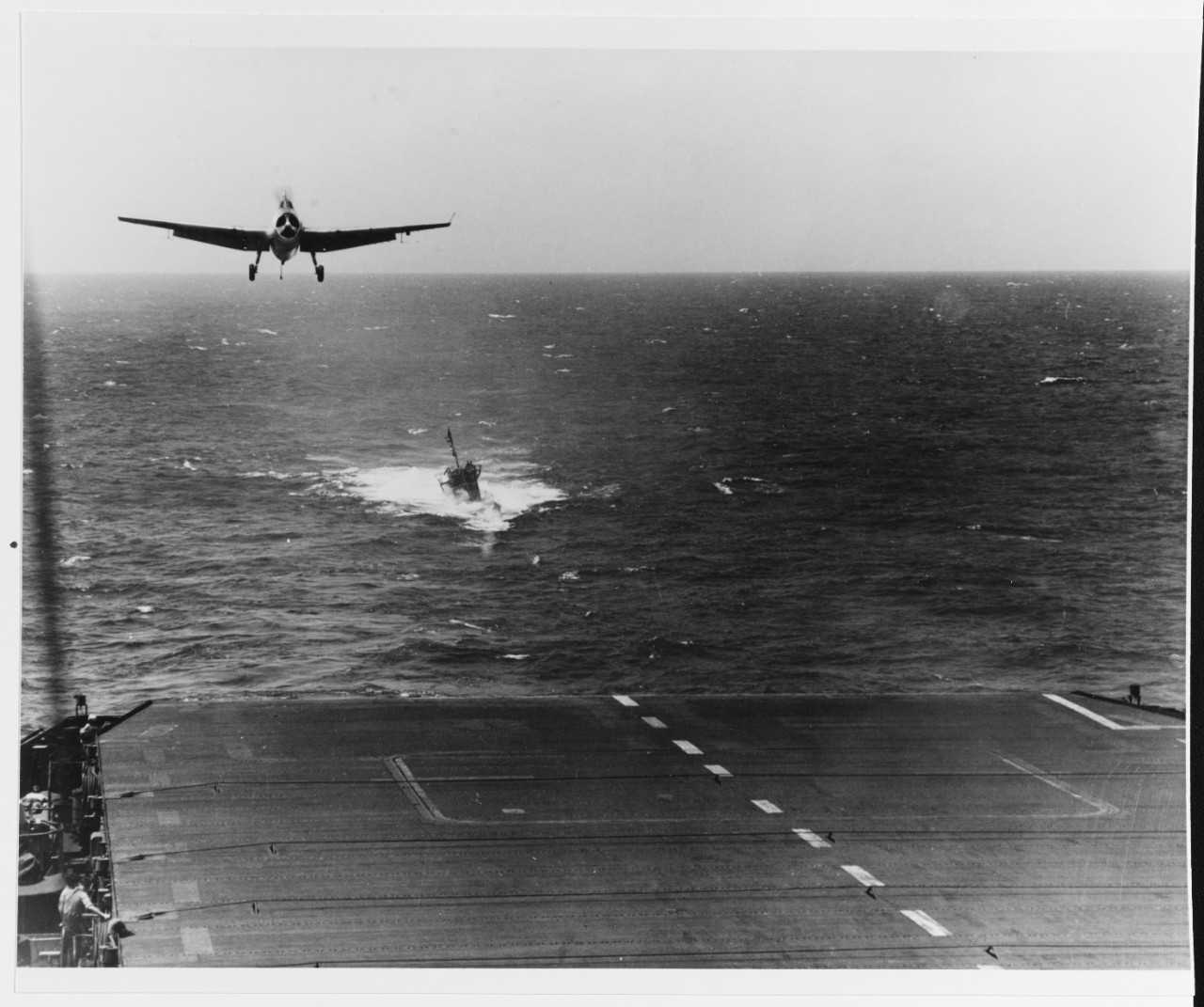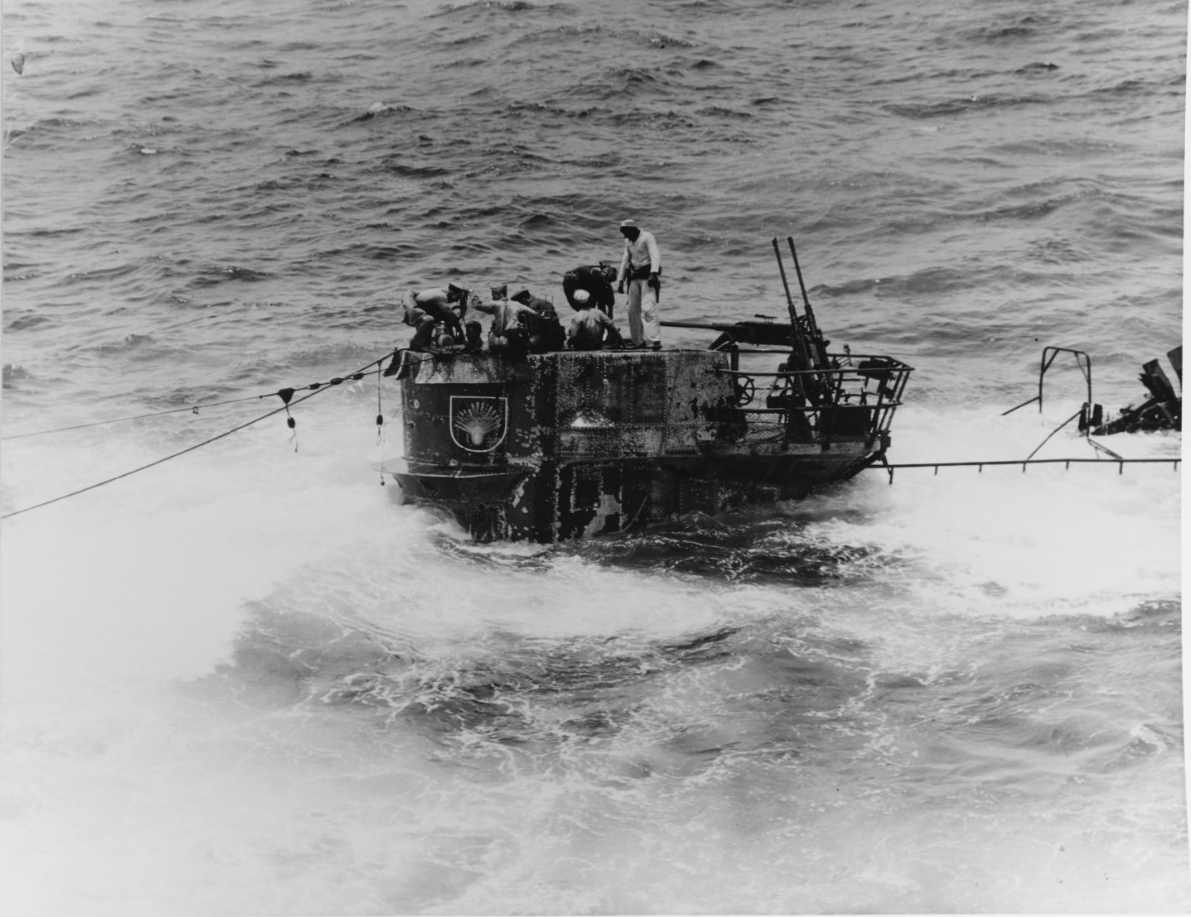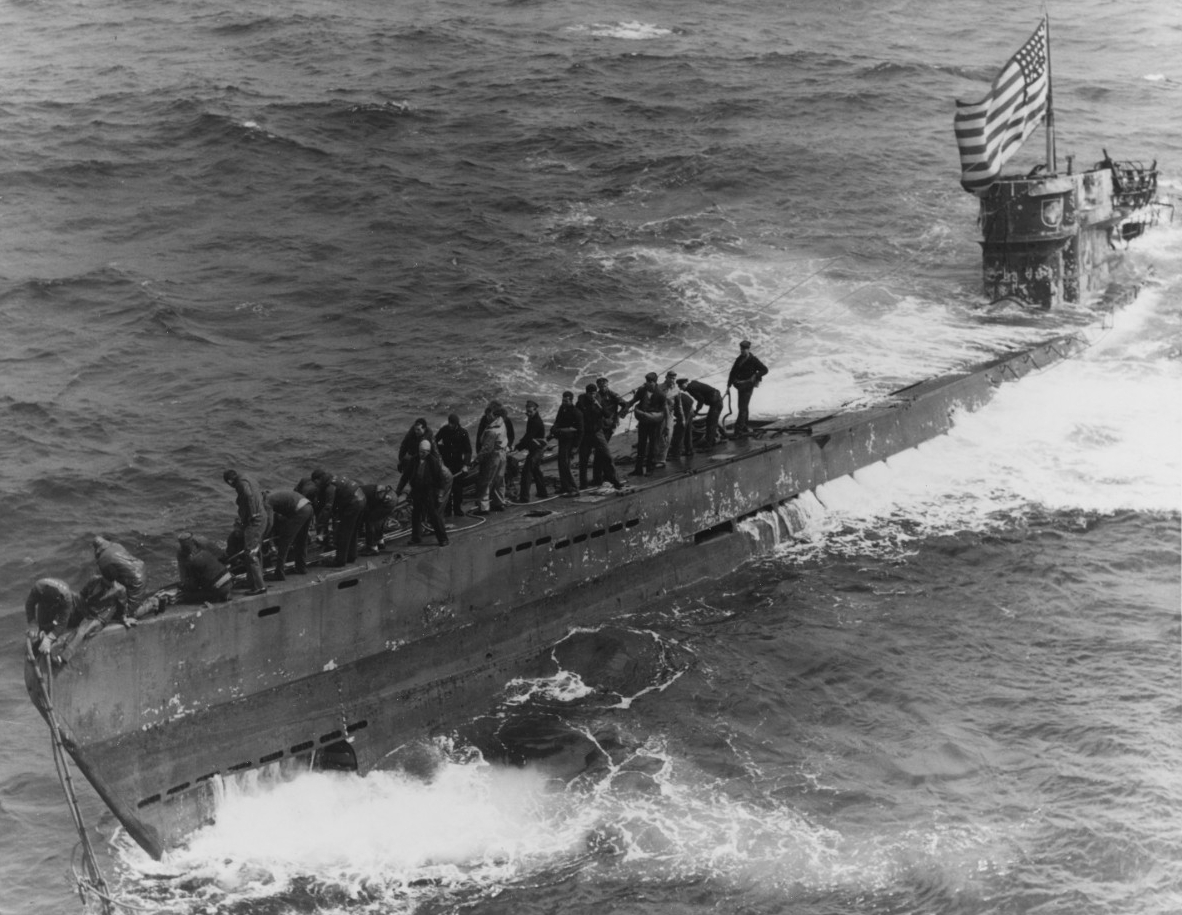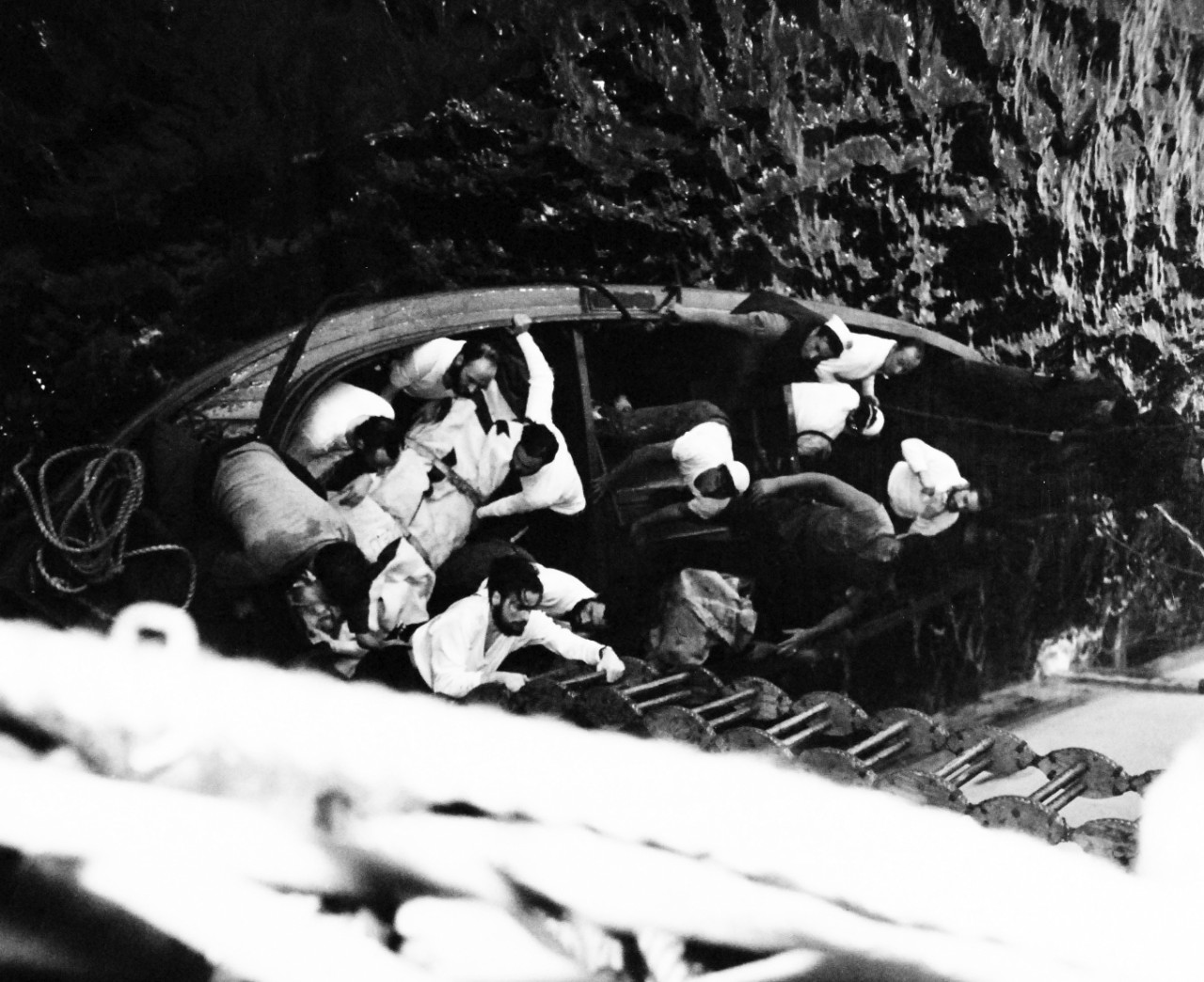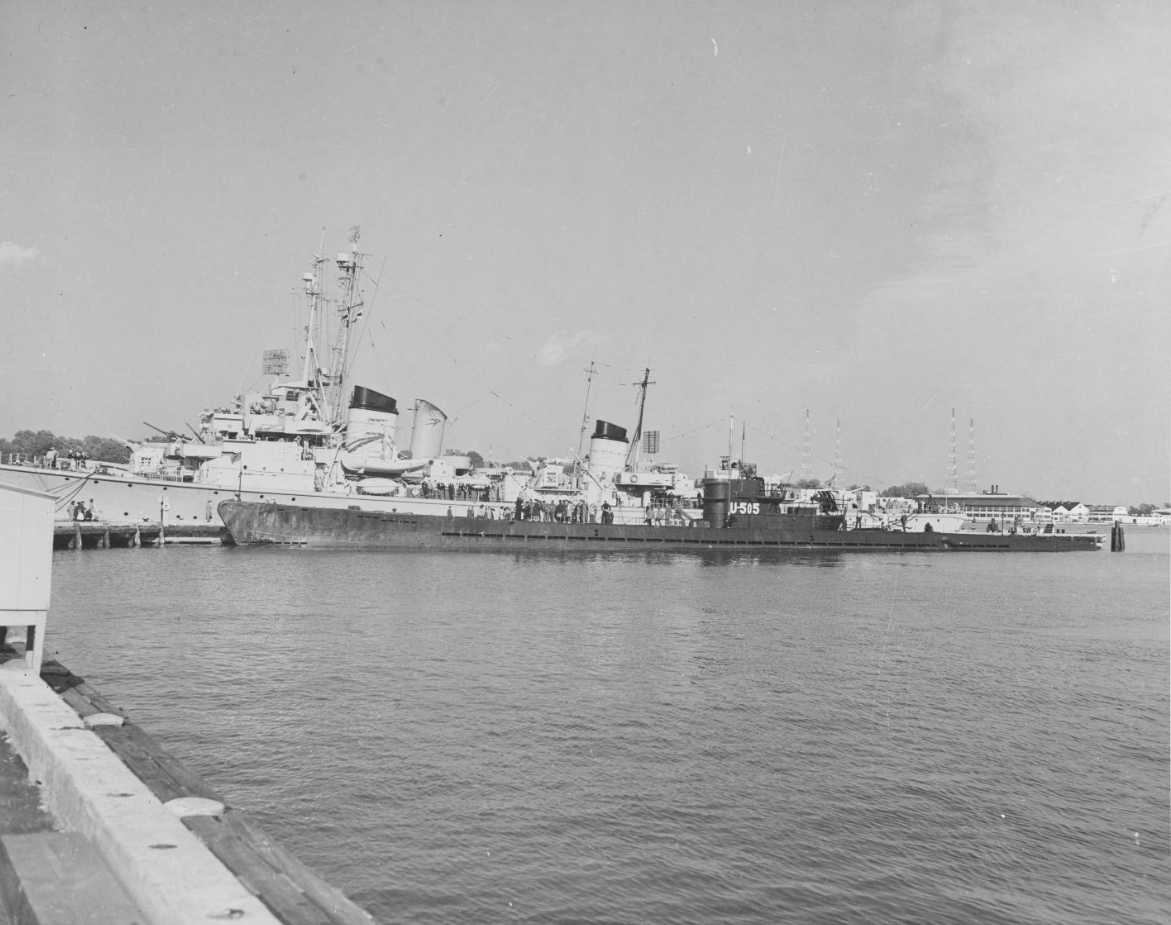H064.3: Close Quarters Antisubmarine Warfare (Part 3)
USS Guadalcanal (CVE-60), USS Chatelain (DE-149), and USS Pillsbury (DE-133) vs. U-505─4 June 1944
U-505 was an ill-starred boat, although others might consider her very lucky, compared to 632 other U-boats lost at sea, most with all hands. U-505 suffered the worst damage of any U-boat that survived, and she was the only U-boat where the commanding officer committed suicide on board in the middle of a depth charge attack. In 12 war patrols, U-505 only sank eight ships totaling 44,962 GRT.
Commissioned on 26 August 1941, U-505 was a Type IXC long range U-boat (see Buckley vs. U-66 for Type IXC characteristics). Her first war patrol was a transit from Kiel, Germany, in January 1942 to Lorient in German-occupied France in February 1942 during which she attacked no ships, nor was she attacked, and was cut short by the commanding officer’s appendicitis. Her second war patrol, starting in February 1942, was her most successful, sinking four cargo ships off West Africa and suffering only minor damage from an Allied aircraft attack in the mid-Atlantic. On her third war patrol, beginning in June 1942, U-505 sank three ships in the Caribbean, one of which was a sailing ship belonging to a Colombian diplomat, which gave Colombia the excuse they were looking for to declare war on Germany.
Under new skipper Kapitanleutnant (Lieutenant) Peter Zschech, U-505 commenced her fourth war patrol in October 1942. After sinking one British vessel off the coast of Venezuela, U-505 was caught by surprise on the surface on 7 November by a low-level attack by a British Royal Air Force Lockheed Hudson twin-engine bomber, which dropped four depth charges and scored one direct hit on U-505. One German watch officer on the conning tower was killed and another wounded, but the Hudson was hit by fragments from the explosion and crashed, killing all five aboard. Damage to the submarine was so severe that Zschech ordered abandon ship, but the engineers believed she could be saved, and they did save the ship. It took two weeks to make the submarine watertight again, but U-505 eventually limped back to Lorient under her own (reduced) power.
Following six months of repair, U-505 commenced her fifth war patrol in July 1943, but she was so hounded by three British destroyers (aided by leaking oil from U-505) that she returned with minor damage after only 13 days. Four more patrols were aborted after only a few days, due to mechanical failure and repeated sabotage by French dockyard workers. Other U-boat commanders began to make jokes insinuating that Zschech was a coward. U-505 commenced her tenth war patrol in October 1943. The sub barely made it out of the Bay of Biscay before being subjected to a prolonged depth charge attack, during which Zschech shot himself in the head with his own pistol in the control room in front of the crew. The first watch officer brought the boat back with only minor damage after Zschech’s suicide. Under a new commanding officer, Oberleutnant zur See (Lieutenant (junior grade)) Harald Lange, U-505 commenced her eleventh war patrol on Christmas Day 1943, returning early again after a few days, although this time because she rescued 33 survivors of German torpedo boat T-25, sunk in the Bay of Biscay by British cruisers.
U-505 departed Brest, France, on 16 March 1944 for her 12th war patrol. Under the command of Oberleutnant zur See Harald Lange, U-505 had a crew of 59: five officers, four chief petty officers, thirteen petty officers, and 37 non-rated enlisted men. U-505’s intended operating area was off the west coast of Africa between Freetown, Sierra Leone (then a British Crown Colony) and Monrovia, Liberia.
Harald Lange was 40 years old, which made him the oldest commander of a front-line U-boat during the war. He was chosen by Admiral Doenitz to act as a “father figure” to restore the morale of the crew after the series of failed patrols and the suicide of Zschech; in that he was successful, as well as instilling a more professional fighting spirit in the crew.
Before the war, Lange was captain of a Hamburg-American line ship and had visited the U.S. multiple times, where he met his wife, a nurse who had emigrated from Germany to the U.S. He joined the Nazi Party in 1934, but was not active, and very few people ever knew he was a member. He became a naval reservist in 1935 but continued in the merchant marine. He was called to active duty in 1939, initially serving in command of a minesweeper and then a patrol boat in the Baltic, when he depth-charged and damaged a British submarine in the Kattegat off Denmark in November 1940.
Lange joined the Unterseebootswaffe in 1941, first serving aboard U-180, a unique Type ID-D1 boat with experimental propulsion. He was aboard U-180 when she went into the Indian Ocean to rendezvous with Japanese submarine I-29 on 23 April 1943 to transfer two Indian allies of the Axis powers who wanted to lead a rebellion in British India. U-180 also took aboard two Japanese naval officers, military equipment, and gold as part of the “Yanagi” technology exchange (see H-Gram 033). Lange temporarily assumed command of U-180 after her return to France before replacing Zschech. He assumed command of U-505 on 30 November 1943.
For U-505’s 12th patrol, her torpedo load included five T-5 Zaunkonig (“Wren”) passive acoustic homing torpedoes, nicknamed by the Germans “destroyer killers” as that was their primary purpose. The weapons were very technologically advanced for the time, but were also extremely maintenance intensive, requiring hours of work every day to keep them operational. They were not to be wasted against merchant ships if at all possible.
It took U-505 twelve days to get out of the Bay of Biscay, as she had to crash dive five times to avoid air attack and was forced to run submerged for 228 hours and surfaced for only 60 hours due to constant Allied air and surface threat.
U-505 rendezvoused with U-154 on 23 March 1944 to transfer radio codes and share intelligence, including learning for the first time about the Allied Hunter-Killer groups. When U-505 entered her assigned operating area, she found it devoid of targets. Morale aboard the crew began to plummet out of boredom and the intense tropic heat. Multiple mechanical systems broke down. The new FuMO radar didn’t work, and torpedo tube II had a jammed bow cap. U-505 had to put divers down on artificial lungs to repair the cap, which took 30 hours. The result of these deficiencies limited U-505 to diving no deeper than 65 feet.
On 27 May, U-505 commenced a return to port, having attacked nothing and sunk nothing. Between 30 May and 2 June 1944, U-505 had to crash dive eight times. The Naxos radar warning system was malfunctioning, giving U-505 less time to detect and react to intense Allied aircraft searches between the Cape Verde Islands and the west coast of Africa, which had become the preferred U-boat transit area.
U-505’s movements had been tracked and analyzed by the U.S. TENTH Fleet since her departure in March 1944. TENTH Fleet was a shore-based organization that never consisted of more than 50 people. It was established on 20 May 1943 by direction of Admiral Earnest J. King, Chief of Naval Operations and Commander-in-Chief U.S. Fleet (CNO/COMINCH), who retained command of TENTH Fleet himself. King’s assistant chief of staff for Antisubmarine Warfare (ASW), Rear Admiral Francis S. “Frog” Low, ran the day-to-day operations. RADM Low was a submarine officer (who had also originated the idea for what became the Doolittle Raid on Japan).
The mission of TENTH Fleet was to serve as a central point for all Intelligence regarding German submarines (with unrestricted access to the British Admiralty’s Submarine Tracking Room) and to conduct operational analysis with the Intelligence for the purpose of tracking and destroying U-boats. TENTH Fleet was given authority to direct U.S. Navy ships in the prosecution of submarines. TENTH Fleet was composed of five major sections: Operations (which included Intelligence,) Anti-submarine Measures, Convoy and Routing, the Civilian Scientific Council, and the Air Anti-submarine Development Unit. In short, TENTH Fleet was responsible for all aspects of ASW weapons and systems development, training, and operations for the purpose of winning the Battle of the Atlantic.
The TENTH Fleet Operations section, headed by Captain Haines, was an Intelligence-driven organization, formed around the nucleus of the Atlantic section of the COMINCH Combat Intelligence Division, led by Commander Kenneth Knowles. Knowles and his team collected, analyzed, and correlated all sources of Intelligence to provide estimates and projections of U-boat activity, and disseminating specific locating information in a timely and tactically useful manner, without compromising the sources of Intelligence. These sources included intercepted and decrypted German communications provided by OP-20-G (the forerunner of Naval Security Group and today’s Fleet Cyber Command/TENTH Fleet) and interrogations of captured U-boat crews by OP-16-Z, the Naval Intelligence Special Activities Branch, among others.
In March 1944, Commander Knowles and his team began tracking what at first appeared to be two submarines transiting the Bay of Biscay, but Knowles quickly concluded it was one submarine. A series of high-frequency direction finding (HF/DF) fixes tracked the submarine down the African coast to Freetown, Sierra Leone. Although the exact identity of the submarine remained unknown, Knowles had enough data to assess it was an older boat with about 90-days mission duration and would turn north to return home near the end of May. U-505 began moving north within its operating area on 24 May, consistent with Knowles’ estimate. On 27 May, a series if HF/DF intercepts fixed the U-boat 750 NM north of its 24 May position, and on 28 May HF/DF fixed the U-boat west of Dakar.
On 30 May, TENTH Fleet tracked the U-boat’s turn to the east to get closer to the African coast trying to avoid the persistent air patrols. TENTH Fleet passed the locating information to Admiral Royal Ingersoll, commander-in-chief of the U.S. Atlantic Fleet, who directed Task Group 22.3, USS Guadalcanal (CVE-60), and escorts, to pursue the contact. At the time Guadalcanal was 300 NM south of the U-boat. On 31 May, HF/DF detected the U-boat resuming its northerly course, with Guadalcanal gaining and with contact estimated to occur on 2 June 1944.
Guadalcanal (CVE-60) was a Casablanca-class escort carrier of 7,800 tons displacement and 512 feet in length capable of operating about 27 aircraft, with one catapult and two elevators. Commissioned on 25 September 1943, Guadalcanal had a crew of about 910-916 (860 ship’s company and 50-56 in the embarked air squadron). Guadalcanal was the sixth of the 50 Casablanca-class escort carriers commissioned in less than two years (the most numerous class of aircraft carrier ever produced). Unlike previous escort carriers like Bogue (CVE-9), Card (CVE-11), and Block Island (CVE-21), which were converted merchant ships, the Casablanca-class were built from the keel up as escort carriers, although the hull was still a modified merchant hull, with the speed of a merchant, only 19 knots at best. For defense, the ships carried one 5-inch/38 caliber gun on the stern, as well as between eight and 16 Bofors 40mm and 12-20 Oerlikon 20mm anti-aircraft guns (numbers increased during the war).
Guadalcanal’s first commanding officer was Captain Daniel Vincent Gallery, Jr. Gallery entered the U.S. Naval Academy in 1917 at the age of 16, and graduated in 1920 with the wartime-accelerated class of 1921. An early naval aviator, he flew seaplanes, torpedo bombers, and amphibians. In 1941, before the U.S. entry in the war, he was assigned as the naval attaché at the U.S. Embassy in Great Britain. He ferried Spitfire fighters from the factory to Royal Air Force airfields; although the planes were unarmed, it gave him technical claim to be the only U.S. naval aviator to fly Spitfires during the Battle of Britain. In 1942, Gallery assumed command of the Fleet Air Base at Reykjavik, Iceland, where he was awarded a Bronze Star for operations against German submarines, and first began to formulate his ideas for how to capture a U-boat.
Guadalcanal’s first Hunter-Killer mission commenced in January 1944, with Captain Gallery dual-hatted as commanding officer of Guadalcanal and Task Group 21.12. Guadalcanal embarked Composite Squadron VC-13, composed of nine FM-1 Wildcat fighters and 12 TBF-1C Avenger torpedo-bombers. The screen consisted of four vintage “four piper” destroyers, all survivors of the debacle in the Java Sea in February 1942 (see H-Gram 003). These ships were Alden (DD-211), formerly commanded by Lieutenant Commander Ernest Evans, the John D. Edwards (DD-216), John D. Ford (DD-228), and Whipple (DD-217).
The Guadalcanal Hunter-Killer group got its first kill on 16 January 1944. Ultra Intelligence (derived from decrypted German Enigma communications) indicated the Germans would conduct a refueling operation just before sunset 500 NM west of the Azores. Guadalcanal and escorts remained clear of the area so as to not alert the Germans, but just before sunset launched eight Avengers. Two Avengers caught three submarines on the surface, U-544 in the act of refueling U-516, and one awaiting its turn. All three immediately began to submerge, but an Avenger fired rockets and dropped two Mk.47 depth charges that landed between U-544 and U-516. U-516 appeared to sink by the stern, but actually survived. About 40 crewmen were abandoning U-544 when the second Avenger hit it with rockets and depth charges blowing the men off the deck. Although about 32 Germans survived the sinking, none were rescued and all 57 hands were lost. U-544 was on her first war patrol with no sinkings to her credit.
The Avengers returned to the carrier very low on fuel as dusk was fading fast. The first five got aboard safely, but the sixth fell into the starboard gallery walkway, fouling the starboard side of the flight deck. Gallery ordered the flight deck lights on despite the risk of submarine attack. As crewmen cut the tail off the Avenger in the catwalk trying to clear the deck, a seventh Avenger tried to hug the port side, but bounced through the barriers and crashed inverted in the water. The last Avenger was then instructed to ditch. Fortunately, all six pilots and aircrewmen from the two planes in the water were rescued. However, VC-13 would lose six Avengers, two pilots, and three aircrewmen to mishap during this line period.
The Guadalcanal Hunter-Killer group was underway again from Norfolk on 7 March 1944 with a different air squadron and escorts. Composite Squadron VC-58 was composed of nine FM-2 Wildcat fighters, three TBF-1C, and nine TBM-1C Avenger torpedo bombers. The screen consisted of the Gleaves-class destroyer Forrest (DD-461), and four new Edsall-class destroyer escorts Pillsbury (DE-133), Pope (DE-134), Flaherty (DE-135), and Chatelain (DE-145), with Commander Frederick S. Hall embarked a screen commander.
The Edsall-class was a follow-on to the Evarts-, Buckley-, and Cannon-class destroyer escorts. Designed to be mass produced ships optimized for convoy escort and antisubmarine warfare, the Edsall class had armament similar to the first three classes, consisting of three single 3-inch/50 caliber guns, one twin Bofors 40mm AA gun, eight single 20mm AA guns, one triple 21-inch torpedo tube mount, one Hedgehog forward firing depth charge projector, eight K-gun side-throwing depth charge projectors, and two depth charge racks on the stern. What made the Edsalls different from previous classes was their diesel-electric power plant similar to that on submarines. A total of 85 Edsall-class destroyer escorts were completed.
After an uneventful crossing of the Atlantic to Casablanca, TG 21.12 was underway again on 30 March 1944 from Casablanca. Guadalcanal supported westbound convoy GUS-37, but found no submarines during daylight flight operations. Guadalcanal proceeded independently on 8 April toward an HF/DF intercept position of a U-boat, attempting night flying operations again under a full moon. Four Avengers were launched just before sunset. One of them found U-515 on the surface recharging batteries and forced the U-boat to submerge with a depth bomb attack. Guadalcanal kept four Avengers in the air all night. Every time U-515 tried to surface to recharge, she was forced back under.
U-515 was a Type IXC U-boat on her seventh war patrol, all under the command of the particularly effective Kapitanleutnant Werner Henke (he already been awarded an Iron Cross Second Class, Iron Cross First Class, and the highest Knights Cross of the Iron Cross with Oak Leaves). U-515 had sunk 23 ships, plus two were damaged that later sank, for a total of about 160,000 tons. On the night of 6-7 December 1942, U-515 attacked convoy ON-149 and torpedoed the 18,700 ton British armed passenger liner Ceramic. Ceramic was hit by one torpedo, and then a couple minutes later by two more in the engine room. Ceramic had 264 crewmembers, 14 gunners, 244 military and naval passengers, including 30 nurses, and 133 civilian passengers including 12 children. Henke waited until eight fully laden lifeboats with crew and passengers were launched before putting two more torpedoes into the ship, which broke her back and sank her immediately.
Henke reported the sinking, but was directed to return to the site and take aboard Ceramic’s master for interrogation. By the time U-515 returned, a severe storm had swamped or capsized the lifeboats. In the gale, U-515 was only able to take aboard one survivor, a sapper of the Royal Engineers. The other 656 people aboard Ceramic perished in the storm. British propaganda would claim U-515 machine-gunned passengers and branded Henke as a wanted war criminal. U-515 had also earlier sunk the destroyer-tender HMS Hecla on 12 November 1942, which sank with the loss of 283 of 846 aboard. In the same convoy and same day, a torpedo from U-515 blew the stern off British destroyer HMS Marne.
Guadalcanal aircraft dogged U-515 throughout the night. By morning U-515 was trailing oil, and being tracked by sonobuoys, when she was attacked again at 0645 by a Wildcat fighter. Throughout the morning the four destroyer escorts closed in on U-515. At 1030, Pope gained sonar contact and delivered several Hedgehog and depth-charge attacks that damaged U-515’s pressure hull. By 1300, large oil bubbles began to break the surface. Having sunk to 600 feet and with his batteries depleted, Henke blew all his air tanks to surface. Chatelain delivered two depth charge attacks, the second just as U-515 broke the surface at 1402 only 75 yards from Chatelain’s starboard beam and within sight of Guadalcanal. Chatelain and Flaherty opened fire on U-515 at point-blank range as Pillsbury raced to get in the action. An Avenger fired rockets and two Wildcats strafed the boat and exploded an acoustic torpedo tracking on Pillsbury, apparently Henke’s last gasp before he ordered abandon ship.
U-515 finally went under at 1512. U-515 suffered 16 dead before U.S. ships ceased fire, but 44 crewmen were rescued, including Henke. Given the amount of time between when U-515 surfaced and when she finally went under, Gallery came to the conclusion it might have been possible to capture the sub, had it not been for the massive amount of firepower directed at the sub when it came up. Henke was taken to the POW interrogation center at Fort Hunt, Virginia. In an attempt to get more valuable information from him, interrogators applied more than the usual psychological pressure, threatening to turn him over to the British to be executed as a war criminal for the Ceramic sinking. In June 1944, Henke was shot and killed as he attempted to escape from the compound; some accounts state this was actually a “suicide-by-guard” action rather than a real escape attempt. Henke was posthumously promoted to Korvettenkapitan (lieutenant commander). His grave is on the post at Fort Meade.
On 9 April 1944, U-214 evaded a depth-bomb attack by Guadalcanal aircraft. U-214 was a Type VIID minelaying submarine and may have been responsible for the loss of U.S. submarine Dorado (SS-248) on 14 October 1943 in a minefield laid by U-214 off Colon, Panama, on 8 October 1943. Dorado’s loss was initially blamed on a “friendly-fire” attack by a PBM Mariner flying boat of Patrol Squadron VP-210, however there is substantial evidence that the Mariner was not at fault. If Dorado was sunk by a mine, it would be the only U.S. submarine sunk in the Atlantic as a result of enemy action.
On 10 April 1944, three Guadalcanal Avengers and a Wildcat caught U-68 on the surface in the moonlight. This time there was no escape. It took until dawn, and U-68 put up heavy anti-aircraft fire, but the U-boat was sunk by depth bombs, rockets, and strafing by two Avengers and a Wildcat, going down with 56 of her crew including her skipper, Oberleutnant zur See Albert Lauzemis. A lookout who was left topside when the sub crash dived was the only survivor and was rescued by one of Guadalcanal’s escorts. The Type IXC U-68 had been a very successful U-boat with 32 ships and one auxiliary warship (a naval trawler) sunk for a total of 201,430 tons. Gallery noted in his action report that 2,100 hours of daylight operations accomplished nothing, whereas 200 hours of night flying resulted in two kills.
Guadalcanal returned to Hampton Roads on 17 April 1944 for upkeep and a change out of air squadrons, with Composite Squadron VC-8 relieving VC-58. VC-8, commanded by Lieutenant Norman D. Hodson, was composed of nine FM-2 Wildcat fighters and twelve TBM-1C Avenger torpedo bombers. The screen commander remained Commander Hall, embarked in Pillsbury. The destroyer Forrest was replaced by Buckley-class destroyer escort Jenks (DE-665). The four Edsall-class (Chatelain, Pillsbury, Pope, and Flaherty) remained part of the Guadalcanal Hunter-Killer group, now redesignated as Task Group 22.3.
At the departure conference in Norfolk, Captain Gallery laid out his plan to capture a U-boat to his senior task group officers and representatives from Admiral Ingersoll’s (CINCLANTFLT) and Vice Admiral Bellinger’s (Commander Naval Air Forces Atlantic) staffs. According to Morison, the plan was well received. According to other accounts, no one present raised an objection. Regardless, Gallery instructed each of his ships to organize a boarding party. TG 22.3 departed Hampton Roads on 15 May 1944 and crossed the Atlantic.
For two weeks, the Guadalcanal Hunter-Killer group found nothing. On 30 May, orders were received from Admiral Ingersoll to pursue the unknown German U-boat (U-505) reported by TENTH Fleet Intelligence. Told to expect contact on 2 June, Guadalcanal’s shipboard HF/DF system gained a bearing on the U-boat on 2 June. Approaching from the south, Guadalcanal aircraft commenced around-the-clock flights, gaining fleeting nighttime radar contacts. Sonobouys dropped from aircraft detected submarine propeller noises but were not able to localize the contact.
On 3 June, Guadalcanal and escorts turned back south and searched the area they had just been through again, flying aircraft all night, this time with no result. Aboard U-505, Lange recorded hearing aircraft depth charges at a great distance; at the time Guadalcanal planes were bombing a “noisy sonobuoy” 60 NM away. Based on radar warning and other acoustic information, Lange actually deduced that he was being pursued by an aircraft carrier. By this time, the Task Group was getting very low on fuel and after sunrise on 4 June, Guadalcanal turned back north to head for Casablanca to refuel.
At 1110, Chatelain radioed possible sound contact. At 1112, the skipper of Chatelain, Lieutenant Commander Dudley S. Knox (only son of Captain Dudley W. Knox, the first and long-time director of the predecessor of the Naval History and Heritage Command), evaluated and reported the contact as a submarine and that he was commencing attack. The Task Group had driven right over the sub, which was between Guadalcanal and the starboard escorts, running just below the surface. Captain Gallery ordered the screen commander, Commander Hall, to send two destroyer escorts to assist Chatelain. Pillsbury and Jenks responded, while Guadalcanal turned to port (west) to clear the area, retaining Pope and Flaherty as escorts. Guadalcanal launched two Avengers to join two Wildcats already airborne. The Avengers were given orders not to drop depth charges if the submarine surfaced.
Chatelain fired a pattern of 20 Hedgehog projectiles at the contact, but no explosions were heard within ten seconds, indicating a miss. Chatelain was circling for another attack, when her sonarmen realized they were heading opposite of the contacts movement. At almost the same time, the Wildcats sighted the submarine below the surface and strafed the water to mark the spot. Chatelain was already moving in the correct direction when Lange put up his periscope for a quick look and was “dismayed by the array of enemies,” and promptly went down scope. U-505 fired a G7es Zaunkonig acoustic homing torpedo at Chatelain, which missed.
Chatelain then fired a pattern of 14 600-pound depth charges set on shallow as she drove over the datum, with devastating effect on U-505. The action had interrupted the lunch serving. The force of the explosions rolled U-505 on her beam ends, throwing crockery, food and sailors into the bilges. Worse, the outer hull was holed, lights and machinery went out, the rudder jammed hard starboard and water began to leak into the boat. Crewmembers from below rushed the conning tower shouting that the boat was sinking. Lange took their word for it, blew his tanks and came to the surface.
At 1122.30, U-505 broached 700 yards from Chatelain. The three destroyer escorts immediately opened fire and the Wildcats strafed the sub. Lange was the first to come up to the bridge and was immediately badly wounded in his legs and face by shell splinters. Next up was the second officer, who was wounded and knocked unconscious. Other sailors attempted to man machine guns and got off a few rounds, before the still conscious Lange looked around and realized the situation was hopeless and gave the order to abandon and scuttle the U-boat. As he was moving to the anti-aircraft deck abaft the bridge another blast blew him onto the main deck below, where crewmen put him in a raft. One German crewman was killed in the fusillade. The crew abandoned with such haste that full scuttling measures were not implemented.
The U-boat was still making way as the crew began to abandon it. Concerned that U-505 was maneuvering to take a torpedo shot, Chatelain fired a torpedo at U-505, which missed. At 1127, it was clear that the Germans had their hands up and were getting into rafts. Commander Hall ordered a ceasefire. Chatelain and Jenks began rescuing the 58 survivors of U-505, three of them wounded, including Lange.
Even though apparently abandoned, U-505 was churning in a tight right turn at 6 knots, slowly settling by the stern. At 1138, Commander Hall ordered “Away boarding parties.” Lieutenant (junior grade) Albert L. David (a “Mustang” with 20 years of enlisted time) was the Pillsbury’s boarding team commander. He set off in a whaleboat with an eight-person team, plus two operating the boat, and salvage gear stowed and ready. Nearby destroyer escorts used .50 caliber machine gun fire to persuade lingering Germans to get off the sub’s deck. Unable to match the submarine’s speed in a stern chase, the coxswain steered the boat across the circle to essentially ram the submarine from the side.
As Lieutenant (j.g.) David led the boarding team in leaping on to the U-boat, the submarine had settled even further in the ocean with swells washing over the entire afterdeck and around the conning tower. Without hesitation, David climbed the conning tower and plunged into the dark interior of the submarine down the conning tower hatch, knowing that any moment the sub might sink, or at any instant they all might be blown to smithereens by scuttling charges, and not knowing if there were any armed Germans below willing to fight. David was followed down by two petty officers, Arthur W. Knispel and Stanley E. Wdowiak. All three were armed with Thompson submachine guns and hand grenades. The boat was dark except for some dim emergency lighting, and they could hear water gurgling. After determining that there were no Germans on board, David called for more of the team to come down.
Knispel and Wdowiak collected the codebooks from the radio room. The code books, charts, and important looking papers were quickly sent topside and into the whaleboat to be sure they weren’t lost. Petty Officer Zenon B. Lukosius found the source of the water entering the interior of the sub. Fortunately the cover of the six-inch (or eight-inch, depending on account) bilge strainer was still lying nearby and Lukosius put it back and dogged it down. By this time, the submarine was almost at neutral buoyancy and water was sloshing down the conning tower hatch; David ordered those topside to close it.
At 1230, a whaleboat from Guadalcanal arrived at U-505 with a salvage party led by Guadalcanal’s engineering officer, Commander Earl Trosino. Trosino assumed command and began tracing U-505’s plumbing to determine how to keep her from sinking. Other members of the Guadalcanal party rigged handy-billy pumps to pump water out of the sub. Although the sub was dark, the boarding teams were not blind as they were armed (in their training) with details of U-boat mechanics and operations, derived from the British capture of U-570 in the North Atlantic in August 1941 (in that case, the Germans had time to smash the Enigma machine and throw the pieces over the side, along with codebooks and other papers, but it was still an Intelligence bonanza). For example, the salvage team knew that U-boats had 14 five-pound scuttling charges that could be on timers set at locations around the boat, but the locations varied from boat-to-boat. Gunner Burr from the Guadalcanal found and disarmed 13 of the charges. The 14th wasn’t found until weeks later, a known danger that hung over the heads of salvage parties over the next week.
CDR Trosino quickly discovered that when he slowed the boat, the stern would sink further as lift from the stern planes was lost. To keep the sub afloat it would need to be towed at a high enough speed. Pillsbury attempted to take U-505 in tow but collided and the sub’s bow planes ripped through Pillsbury’s hull, flooding two main compartments. Guadalcanal then backed down on the sub and a tow line was put across. As Guadalcanal took up the strain and increased speed, U-505’s stern came up, but the jammed rudder caused the sub to shear off to the starboard (although in the photo it looks like port to me). With the four aircraft airborne low on fuel, Guadalcanal turned into the wind and recovered the planes with U-505 in tow. The efforts to keep U-505 from sinking over the next days were an epic in themselves.
On orders of Admiral Ingersoll, Captain Gallery was directed to take the Task Group and U-505 to Bermuda. As the group was very low on fuel, the risk was accepted to bring the tanker Kennebec (AO-36) out of the safety of Casablanca, which led to a unique situation in the history of the U.S. Navy of a carrier conducting flight operations and alongside underway replenishment from an oiler while towing a submarine. Finally, on 9 June, the tug Abnaki (ATF-96) took over the tow, and the Task Group formed a protective screen around the tug and tow. An experienced submarine officer, Commander C. G. Rucker, was put aboard for the final leg to Bermuda, arriving on 19 June.
Reportedly, Fleet Admiral King was torn between decorating and court-martialing Captain Gallery for capturing the sub, rather than sinking it after taking all code materials off. In the case of U-570, the Germans were able to radio to the German high command that they had successfully deep-sixed the Enigma machine and all code material so the Germans were not worried about compromise (although they should have been). If the Germans were to find out that U-505 had been captured and not sunk, they would have no choice but to assume the Enigma machine had been compromised, which would put at risk an enormously valuable source of Allied Intelligence (which even Morison didn’t know about when he wrote the “History of U.S. Naval Operations in World War 2” in the 1950s). As a result, a very extensive effort was undertaken to keep the Germans from learning of U-505’s capture.
Upon arrival in Bermuda, 3,000 witnesses to the capture were sworn to secrecy, and any “souvenirs” were collected. U-505 remained at the U.S. Navy operating base at Bermuda. It was painted as a U.S. submarine and named USS Nemo. It was studied intensely, including underway operations, as was the sensitive acoustic torpedo technology. The cipher machines and code books also resulted in valuable Intelligence. The two Enigma machines saved Navy codebreaking teams an estimated 13,000 computer hours.
The 58 U-505 survivors were kept isolated from all other prisoners of war, eventually being sent to a camp near Ruston, Louisiana. Lange had a leg amputated due to his wounds. The Red Cross was denied access (or even knowledge of their existence) and they were forbidden to write to their families. The Germans never did learn of U-505’s capture during the war and the German navy finally officially declared U-505’s crew dead in August 1944. The crew was transferred to Great Britain in 1945. Their families were not notified they were alive until 1946, and they were not returned to Germany until December 1947.
Lieutenant (junior grade) Albert Leroy David was awarded the Medal of Honor for his actions in capturing U-505. It was the only Medal of Honor awarded to U.S. Navy personnel in the Atlantic Theater during World War II. Regrettably, he died of a heart attack in September 1945 (at age 43) before the medal was presented;
“The President of the United States of America, in the name of Congress, takes pride in presenting the Medal of Honor (Posthumously) to Lieutenant (then Lieutenant (junior grade)) Albert Leroy David, United States Navy, for conspicuous gallantry and intrepidity at the risk of his life above and beyond the call of duty while attached to the USS Pillsbury (DE-133) during the capture of an enemy submarine off French West Africa, 4 June 1944. Taking a vigorous part in the skillfully coordinated attack on the German U-505 which climaxed a prolonged search by the Task Group, LT David boldly led a party from Pillsbury in boarding the hostile submarine as it circled erratically at five or six knots on the surface. Fully aware the U-boat might momentarily sink or be blown up by exploding demolition and scuttling charges, he braved the added danger of enemy gunfire to plunge through the conning tower hatch and, with his small party exerted every effort to keep the ship afloat and assist the succeeding and more fully equipped salvage parties in making U-505 seaworthy for the long tow across the Atlantic to a U.S. port. By his valiant service during the first successful boarding and capture of an enemy man-o-war on the high seas by the US navy since 1815, Lieutenant David contributed materially to the effectiveness of our Battle of the Atlantic and upheld the highest traditions of the US Naval Service.” Garcia-class frigate FF-1050 was named in honor of Albert David, in commission from 1968 to 1988, then serving in the Brazilian navy.
Torpedoman’s Mate Third Class Arthur William Knispel, USNR, and Radioman Second Class Stanley Edward Wdowiak, USNR, were each awarded the Navy Cross for their actions in capturing U-505. Other members of the original boarding team were awarded the Silver Star. Commander Earl Trosino was awarded the Legion of Merit. Captain Daniel Gallery was awarded the Distinguished Service Medal after all and the entire Guadalcanal Hunter-Killer group was awarded a Presidential Unit Citation. Admiral Ingersoll cited the Task Group for “outstanding performance during anti-submarine operations…a feat unprecedented in individual and group bravery, execution and accomplishment in the Naval History of the United States.”
At the end of the war in Europe, U-505 was used to promote E War Bond sales, and the sub visited New York City, Philadelphia, Baltimore, and Washington D.C. She was then moored in derelict condition at Portsmouth Navy Yard. With great difficulty, Rear Admiral Gallery convinced the Navy not to sink U-505 as a target. In 1954, the Navy donated U-505 to the Chicago Museum of Science and Industry, and citizens of Chicago raised $250,000 to transport the boat up the Great Lakes. The museum placed U-505 in a climate-controlled building in 2004, which underwent a major exhibit upgrade in 2019 that is truly amazing.
Guadalcanal was decommissioned in 1946 and scrapped in 1959. Pillsbury depth charged and sank U-546 on 24 April 1945, was decommissioned in 1947, recommissioned as a radar picket in 1955, decommissioned again in 1960, and scrapped in 1966. Chatelain was decommissioned in 1946 and scrapped in 1974.
Sources include: “The U-505’s Service History before Capture: Harald Lange” by S. M. O’Connor, 6 June 2019 at inthegardencity.com. “Escort Carriers: The USS Guadalcanal” prepared by Don Baker at uboat.net. “USS Guadalcanal” entry in NHHC Dictionary of American Naval Fighting Ships (DANFS) by NHHC historian Mark Evans, 2018 at history.navy.mil. History of U.S. Naval Operations in World War II, Vol. X, The Atlantic Battle Won, by Rear Admiral Samuel Eliot Morison: Little, Brown and Cp., Boston, 1957. DANFS for other U.S. ships and uboat.net for German submarines and personalities.
More photos of the capture of U-505 from the NHHC Photo Archives.

